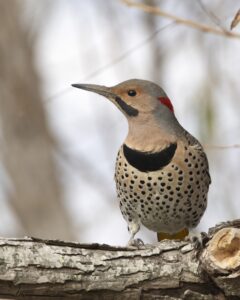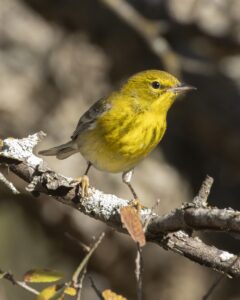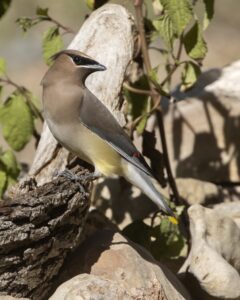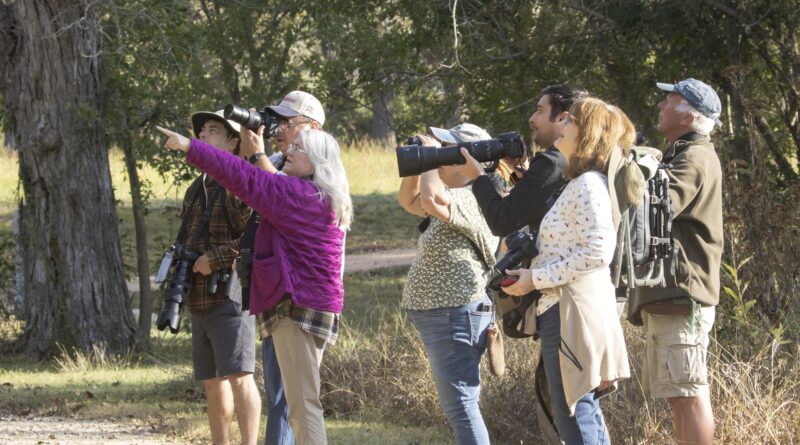Twin Lakes Audubon Society encourages backyard birding
By AMY ROGNLIE | Photos courtesy of the TWIN LAKES AUDUBON SOCIETY

If you think you need to travel to find good areas to observe birds, think again! Some of the best viewing areas are in your backyard — both figuratively and literally — right here in Bell County.
“Central Texas is a unique area for bird watching,” said Deidre Dawson, president of the Twin Lakes Audubon Society. “We are in the middle of two regions, so we get birds from both areas, such as the Woodhouse’s Scrub Jay from the west and the Pileated Woodpecker from the east. And one of the best places to go birding is right here in Temple, at Temple Lions Park.”
Another favorite haunt of both birds and birders is an area near Witter Lane in South Temple, where egrets and herons, as well as a pair of bald eagles, are often spotted. Stillhouse Hollow Lake and Slough Pond are also excellent sites for a rewarding bird-watching expedition, whether you can only stop by for a few minutes after work or spend several hours on a Saturday morning.
If you’d like to learn more about birding, the Twin Lakes Audubon Society would love to have you join them. According to Dawson, TLAS is for all levels of birders, not just experts, or those who have been birding for a long time.
“We are a very a sociable group,” Dawson said. “Our meetings begin with refreshments, and people sharing which birds they have seen in their yards and around the Temple-Belton-Salado area. We welcome anyone who has a love for and interest in birds and wildlife in general.”
A chapter of the National Audubon Society, the Twin Lakes Audubon Society is the only organization in the area devoted to the conservation and appreciation of birds. To fulfill this mission, they offer educational lectures at their monthly meetings, as well as monthly field trips led by a local birder who is knowledgeable about the species here and their ecology. At least once a year they organize overnight field trips to other birding hotspots in the state such as Rockport and High Island.
These educational lectures and field trips provide the community with opportunities to learn more about the rich bird life of Central Texas and beyond. TLAS also supports other organizations devoted to the conservation and well-being of birds, such as the Warbler Woods Bird Sanctuary and Wildbird Rehab.

The Twin Lakes Audubon Society has also forged a unique partnership with wildlife conservation efforts at Fort Cavazos. Past president Gil Eckrich served as wildlife biologist in the Natural Resources Management Branch at Fort Cavazos, and past president Scott Summers currently holds the position of outreach coordinator at Fort Cavazos. Summers has been integral in the military’s special protection program for the native golden-cheeked warbler and black-capped vireo, both of which were locally endangered because of cowbirds.
TLAS has also conducted the annual Christmas Bird Count, the nation’s longest running community science bird project, in our area since its founding in 1987. The count, which took place for the first time on Christmas Day of 1900, provides valuable information about changes in the bird population such as the numbers of individual birds and changes in the range of particular species.
“I think we can be proud of the fact that there were 33 participants in the 2024 CBC, the greatest number in the last 25 years. This is the result of our continued efforts to educate the public about the importance of bird conservation and our collaboration with other local groups such as the Texas Master Naturalists,” Dawson said. “There is a strong commitment to volunteerism among the residents of Bell County, and their eagerness to put their skills and knowledge to work where they are needed is impressive. I see this commitment among the members of TLAS, who come from a variety of professional backgrounds, but who are united in their love of birds and their desire to put their passion to work to improve the quality of the environment for people and wildlife.”
TLAS meets on the campus of the University of Mary Hardin-Baylor in Belton on the second Thursday of every month except March, June, July and August. Membership in the group requires payment of annual dues, with free membership for students
GET INVOLVED: Facebook.com/TwinlakesAudubon
Top 10 Birding Tips

Twin Lakes Audubon Society Vice President Daniel Kelch shares these tips for birding:
- You don’t need to travel or invest in expensive equipment to be a bird watcher. Birds can be found everywhere: in a park, a city block, or in your backyard.
- Start small. You do not need 15 birdhouses and feeders to attract birds.
- Provide fresh water, food and shelter from predators and the environment.
- Offer different types of food to attract more bird species. Be patient: it takes time for birds to find your yard.
- Clean feeders often, inside and out: every 2-5 days for hummingbird feeders and every 1-2 weeks for all others.
- Turn outdoor lights off during spring and fall to help migrating birds find their way!
- Keep cats indoors unless under supervision.
- Plant native plants and remove invasive or exotic plants.
- Join an Audubon group to learn from others.
- Get the eBird app for your phone to record your sighting, and the Merlin app for help with bird IDs. Both apps are free from the Cornell Laboratory of Ornithology and enhance the fun of bird-watching. You can also visit the eBird website, www.ebird.org.




